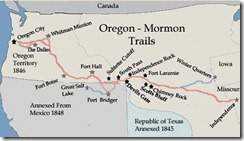When my parents eloped in a black Plymouth Coupe from a nook of Idaho, up over the 9,000-foot Centennial Mountains to Bozeman, Montana, just eight days before VE-Day, they formed the union of two families who 98 years earlier had journeyed west together in 1847 on the first 72-wagon train along the Mormon Trail. That vanguard caravan included just 143 men, 3 women, two children, 17 dogs, 19 cows, 52 mules, 66 oxen, 93 horses and a few chickens.
With no other settlement of significance until the West Coast and no one who had taken the trail before, it took them just 120 days, averaging eight and one-half miles a day to reach the edge of the Great Basin a year before it was annexed from Mexico. We know because they were also the first along that trail to use an improvised “odometer.”
Their mission included establishing fords and ferries, planting crops for those who would come later, gathering information on trail conditions, Native American tribes and water sources along the way as well as designating a gathering point on the other end.
I didn’t know that it wasn’t exactly “make-believe” to my DNA when, as a pre-schooler, I played on an ancient covered cook-wagon behind our ranch house that was used for many years during round ups.
I don’t think I was even aware of this connection when, as a nine-year-old, watching the first season of the TV series Wagon Train, set a decade after my ancestors made that trek up and over the Great Divide to the Geography of Hope.
A carriage-maker by trade, one of my great-great grandfathers, just six years removed from a life as an Upper Providence-Quaker and a heritage dating to William Penn’s arrival, Charles Alfred Harper turned right around just a month after the vanguard company’s arrival at its final destination in a valley below a Wasatch Mountain bench and re-traced the route back to assist an eight-times-longer, 560-wagon train crossing in 1848.
He returned many more times over the next twenty years to assist many of the 69,000 others who traversed that route by wagon or handcart or foot or horseback. He served both as a captain of some trains and a wheelwright or mechanic on others until finally the transcontinental railroad was completed.
Fortunate to have both a facsimile and type-written copy of Captain Harper’s diary of that first trek, I hope I’m humbled by memories of this part of my DNA the next time I am frustrated or annoyed by having to wait for a road-work flagman or a delayed or cancelled flight or any kind of traffic back-up.
No comments:
Post a Comment